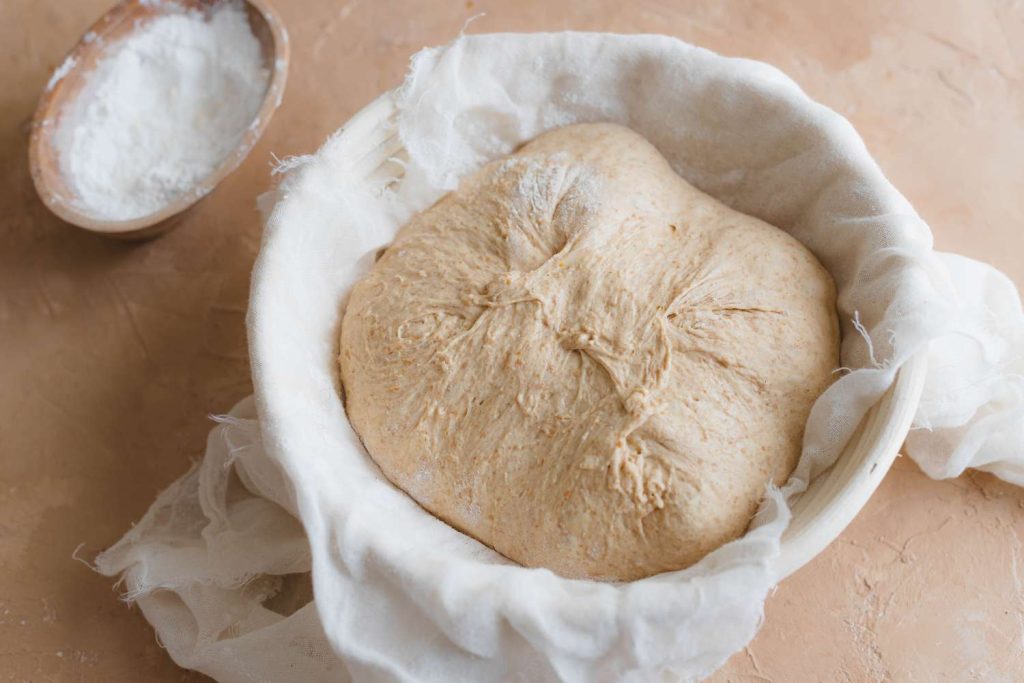When it comes to making delicious homemade bread, one of the most crucial steps is getting your dough right.
Bread dough will be the foundation of any tasty loaf, roll, or bun you end up baking, and having a good understanding of what goes into creating a successful batch can make all the difference in its taste and texture.
In this blog post, we’ll provide an easy-to-follow guide for how to store, make and check whether your bread dough has risen well or not so you can feel confident about each and every batch you bake.
Read on to learn exactly how best to handle your bread dough!
[TOC]
Tips for Leaving Your Bread Dough Out Overnight
Before you start leaving your bread dough out all night, there are some tips and tricks you should know.
1. Temperature
The temperature of your kitchen can greatly affect the success of leaving your bread dough out overnight.
For optimal results, the temperature needs to be between 68-75°F (20-24°C). If your kitchen is cooler than 68°F (20°C), the fermentation process will take longer and may not produce favorable results.
On the other hand, if it’s warmer than 75°F (24°C), the fermentation process will be sped up and can cause over-fermentation. This could lead to an overly sour taste or an off texture in your finished loaf.
You can check the temperature of your kitchen with a digital thermometer or by opening a window if it gets too warm.
2. Covering Your Bread Dough:
When leaving your bread dough out overnight, it’s important to make sure that it is covered with plastic wrap or a damp towel so that it doesn’t dry out. The covering prevents air from coming into contact with the dough and drying it out before it’s ready for baking.
Additionally, covering helps keep impurities away from the dough that could affect its flavor and texture like dust particles or insect pests.
Make sure that whatever you use as a cover is large enough so that it completely covers the bowl containing your dough without touching it directly – otherwise this could affect how well is rises!
3. Timeframe
Depending on how warm or cool your kitchen is, leaving your bread dough out overnight can take anywhere between 8-12 hours for fermentation and rising to complete successfully.
If you plan on baking in the morning, try planning ahead by mixing up your ingredients at least 8 hours before baking so that they have time to properly ferment and rise while still being fresh when you bake them!
What Are the Main Ingredients of Bread Dough?
The main ingredients of bread dough are flour, water, yeast, and salt. Flour provides the structure for your dough, while water hydrates it.

Yeast activates fermentation and causes the dough to rise by releasing carbon dioxide gas. Salt helps control the flavor of the yeast and can also help slow down its rising process.
Depending on the type of bread you are making, additional ingredients like sugar, butter, eggs, and spices may be added to enhance the flavor or texture of your dough.
How Do You Make the Perfect Bread Dough?
Making the perfect bread dough requires a few simple steps.
- Start by mixing together the dry ingredients – flour, yeast, and salt in a bowl.
- Then, add in your wet ingredients – water and any other liquids you might be using.
- Using your hands or an electric mixer with a dough hook attachment, knead the mixture until it forms a smooth ball.
- Once the dough is ready, place it in a bowl and cover it with plastic wrap or a damp towel. Let your dough rise in a warm, draft-free area until doubled in size (8-12 hours).
- Finally, shape the dough into loaves and bake according to the recipe instructions!
Does Bread Dough Need Eggs?
No, bread dough usually does not need eggs.
Adding eggs to basic bread dough can help make it richer and more flavorful, as well as improve its texture and rise better.
That being said, you don’t have to use eggs every time – there are plenty of recipes that call for just the traditional ingredients (flour, water, yeast, and salt) to make delicious bread.
What to Do if Bread Dough Is Too Dry?
If your bread dough is too dry, it usually means you either added too little liquid to the dough or over-kneaded it.
To fix this problem, add a few tablespoons of water to the dough and knead until it becomes more pliable. You can also let the dough sit for about 10 minutes before continuing with the recipe.
Once the dough has become less dry, proceed with kneading, shaping into loaves, and baking according to the recipe instructions! Enjoy your delicious bread!
What Happens if You Leave Bread Dough Overnight?
Leaving your bread dough overnight allows the fermentation process to take place.
This breaks down the starch in the flour and produces carbon dioxide gas, which causes the dough to rise and become light and airy.
For best results, leave your dough in a warm (68-75°F/20-24°C), draft-free area to avoid over-fermentation and resulting in a sour taste or the texture.
Cover the dough with plastic wrap or a damp towel to keep it from drying out.
Can I Refrigerate the Dough After the First Rise?
Yes, you can refrigerate your dough after the first rise. This will slow down fermentation and prevent it from over-rising.
When ready to bake, take the dough out of the fridge and let it come to room temperature before shaping it into loaves and baking it in the oven.
Be mindful that this may take a few hours depending on how cold your fridge is.
How Long Does Dough Need to Be Out of the Fridge Before Baking?
It depends on the temperature of your kitchen.
If your kitchen is warm, it will take about an hour for the dough to come to room temperature before baking.
However, if your kitchen is cool, it could take anywhere from 2-4 hours for the dough to properly rise and become ready for shaping and baking.
How Long Can Uncooked Bread Dough Stay in the Fridge?
Uncooked bread dough can stay in the fridge for up to 5 days before it needs to be baked. The longer you store it in the fridge, the more sour and yeasty it will become.
To avoid this, try baking your dough within 3 days of refrigeration.
To keep your dough fresh, make sure to wrap it tightly in plastic wrap or place it in a sealed container. This will prevent any air from getting in and drying out the dough.
Once you’re ready to bake, shape the dough into loaves, let them rise until doubled in size, then pop them into the oven and bake according to the recipe instructions! Enjoy your freshly homemade bread!
How Do You Tell if the Bread Dough Has Risen Enough?
One way to tell if your bread dough has risen enough is to press two fingers into the top of it.
If the indentations remain, your dough has risen enough and is ready for baking.
If not, let it sit a little longer and check again. You can also try floating a small piece of the dough in some cold water – if it floats, your dough is ready to bake!
What to Do if Bread Dough Is Too Sticky?
If your bread dough is too sticky, it usually means you either added too much liquid to the dough or didn’t knead it enough.
To fix this problem, sprinkle some flour onto the sticky surface of the dough and knead it in until it becomes less sticky. You can also let the dough sit for about 10 minutes before continuing with the recipe.
Once the dough is no longer sticky, proceed with kneading, shaping into loaves, and baking according to the recipe instructions! Enjoy your delicious bread!
What’s the Best Way to Store Bread Dough?
Let’s take a look at some of the best ways to store bread dough so that it tastes delicious.
1. Refrigerating Your Dough
The refrigerator is the most common method for storing bread dough overnight. This method works best if you plan to bake within two days; any longer than that and your dough may start to go stale.
When refrigerating your dough, make sure that it is tightly sealed in an airtight container or bag, otherwise, the cold air from the fridge will dry out your dough.
You also want to make sure that there are no other strong odors in your fridge as they can transfer over to your bread.
2. Freezing Your Dough
If you plan on keeping your bread dough frozen for longer than two days, then freezing is the best way to go.
To freeze your dough, first, wrap it tightly in plastic wrap and then place it in an airtight freezer bag or container before placing it in the freezer.
When defrosting frozen bread dough, be sure to do so slowly in the refrigerator as rapid changes in temperature can cause problems with rising time and texture.
It’s also important that you allow enough time for full thawing before baking—this usually takes about 12 hours in total depending on the size of the loaf.
What’s the Difference Between Bread Dough and Regular Dough?
Many people make assumptions that they’re one and the same, but the fact is there are significant differences between these two types of dough. Let’s break down the details.
1. Composition of Ingredients
The main difference between bread dough and the regular dough is in the ingredients used to make them.
Bread dough typically contains yeast, which causes it to rise during baking and gives it its signature texture.
The regular dough does not contain yeast, so it will not rise when cooked. Instead, it will remain relatively flat and dense after baking.
2. Baking Process
The baking process for each type of dough is also quite different due to the presence or absence of yeast.
When baking bread, you need to give it time to rise before cooking it in an oven at a high temperature for a set amount of time.
This allows the yeast to activate and create air pockets throughout the dough, giving it its unique texture and flavor.
With the regular dough, you don’t need to give it any time to rise; instead, you can bake it immediately at a lower temperature for a shorter amount of time than with bread dough.
This results in a denser and firmer finished product than bread dough.
3. Uses
Due to their different compositions and baking processes, bread dough and regular dough have different uses as well.
Bread is often used as a side dish or snack food while regular dough can be used for things like cookies, pies, tarts, pizza crusts, pasta dishes, dumplings, etcetera.
Additionally, some recipes may call for either type of dough depending on what kind of end result you’re aiming for—bread-like or otherwise!
Conclusion:
Leaving your bread dough out overnight has many benefits – most notably creating more flavorful loaves due to slow fermentation – however, there are several things to consider when doing so such as temperature control and making sure that you cover your bowl correctly for protection against dust particles or pests.
Whether you choose to refrigerate or freeze your bread dough overnight, proper storage is key for getting great results when the baking day finally arrives!
Make sure that your containers are airtight so that moisture doesn’t escape and be sure to give yourself enough time for thawing before baking if necessary.
With these tips in mind, you’ll be able to create delicious loaves of fresh-baked homemade bread every time!
Amazon and the Amazon logo are trademarks of Amazon.com, Inc, or its affiliates.

